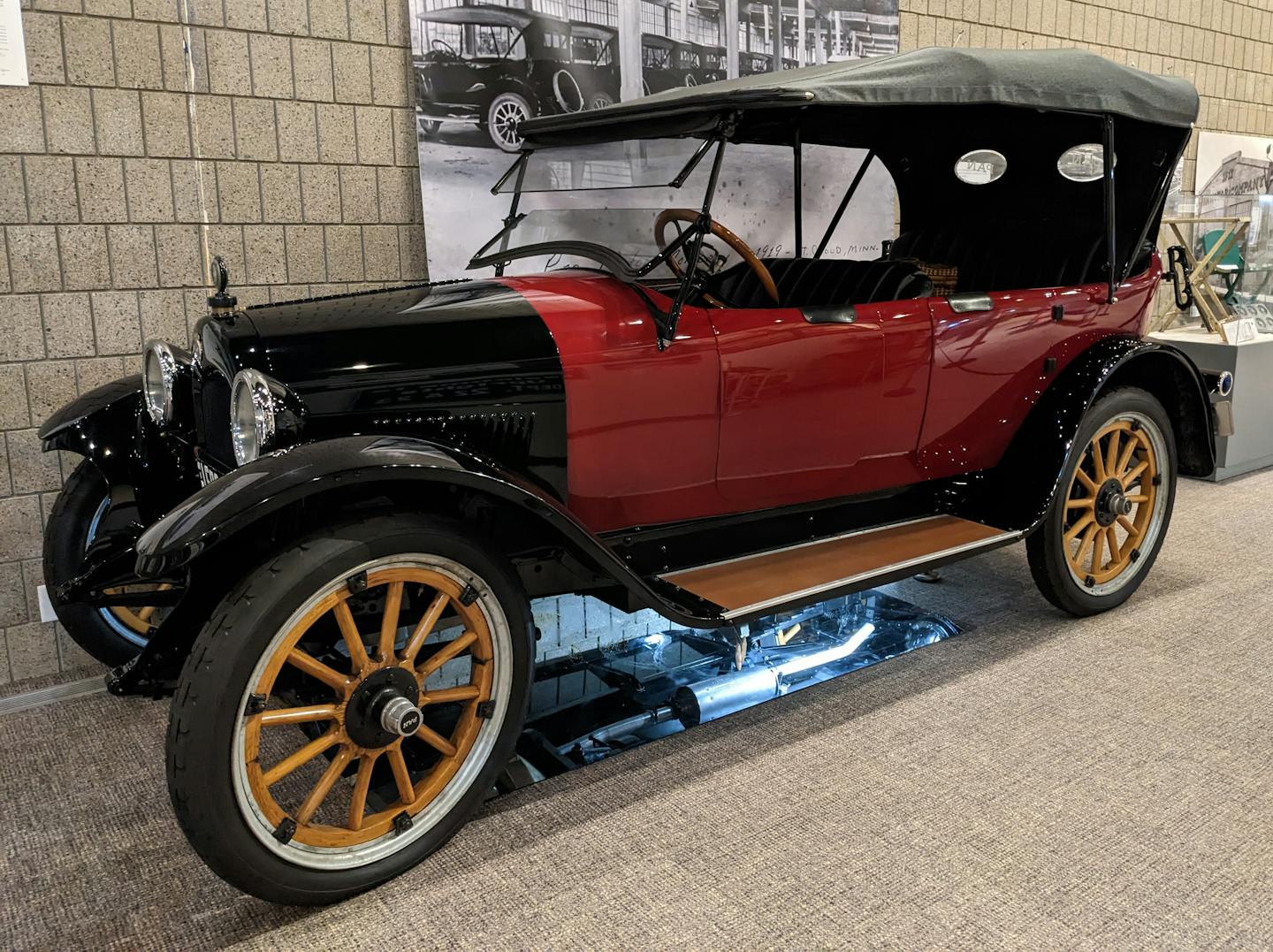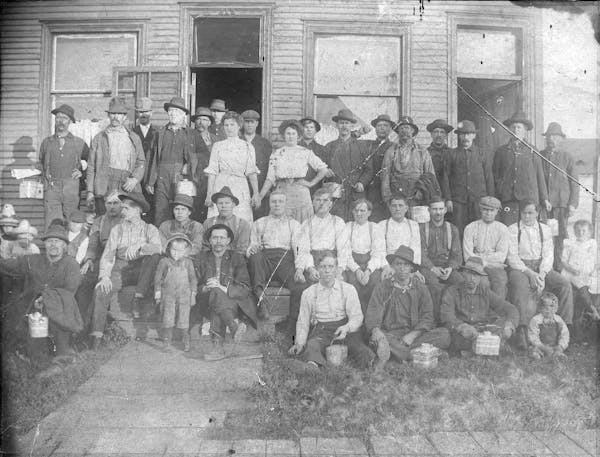Listen and subscribe to our podcast: Via Apple Podcasts | Spotify | Stitcher
St. Cloud was on the cusp of becoming a major car manufacturing hub more than a century ago, fueled by an ambitious entrepreneur bent on disrupting the American auto industry.
Samuel Pandolfo's vision for a new type of automobile — and a town of people to manufacture it — imploded after fewer than a thousand cars had been built. But his failed dream remains a prominent bit of local lore in St. Cloud, where a brewery, auto club and even a neighborhood bear the "Pantown" name — an homage to the short-lived Pan Motor Co.
Pandolfo's ambition and ultimate downfall caught the interest of David Bohline, who wrote to Curious Minnesota, the Star Tribune's community reporting project fueled by reader questions. He said he only recently learned about Pan Motor Co. despite growing up in Minnesota and thought others might be interested in the tale.
"It was a pretty upscale car in its day and it seems like the employees regarded him highly," Bohline said. "But then the back story — that's quite the black mark."
Before the company could truly take off, Pandolfo was found guilty of defrauding investors by false advertising. Questions remain about whether Pandolfo was a garish swindler or simply an eager salesman — or maybe even the victim of sabotage from one of the competing automobile makers at the time.
"Was he a crook? Was he a business guy [with] somebody out to get him? For us, there's not enough documentation to kind of lean one way. I think that's the fascinating thing — you just don't know," said Steve Penick, archivist at Stearns History Museum.
A salesman comes to town
A Mississippi native, Pandolfo worked as an insurance salesman for several years before coming to Minnesota. Pandolfo became interested in automobile design and production after making dozens of trips across the southwest for his work, according to his first-person account kept at Stearns History Museum.
His long treks with few hotel options prompted Pandolfo to design a car ideal for a traveling salesman. It included a front seat that reclined into a bed, headlights that swiveled in case the driver needed to work on the engine, and special compartments to store extra gas, oil, water and ice to keep food fresh. All were innovative at the time.
"I became very interested in car construction and what a car should be," he said. "I retired from the insurance business in March 1916 for the purpose of promoting and building a good car."
He picked St. Cloud because of its proximity to materials from the Iron Range, transportation via two transcontinental railroads and the abundance of farmers who he said were natural mechanics and could be trained for factory work.
Pandolfo then built the largest drop forge in the region to stamp out parts and started erecting houses for his workforce in an area he called "Pan-Town-on-the-Mississippi."
Pan Motor Co. was incorporated in January 1917. By July, Pandolfo had organized a barbecue attracting about 70,000 people to St. Cloud — basically quintupling the city's population for a day. At the event, Pandolfo showcased early Pan prototypes and had employees work the crowd to sell company stock.
A would-be empire crumbles
Just as crews started turning out Pan Motor Co. Model A cars in earnest, Pandolfo was indicted on charges of mail fraud in Chicago based on alleged misstatements and exaggerations in a book Pandolfo sent to prospective investors.
Prosecutors argued that an "aeroplane view" drawing in the literature was misleading because it wasn't a photo taken by airplane. Another concern was a promise that the plant could manufacture about 10 cars a day within two months of when the brochure was sent. But shortly after Pandolfo mailed the brochure, the government heavily restricted automotive production because of World War I.
Pandolfo was found guilty on four of 11 counts and sentenced to 10 years in prison, though he ended up serving about three and was released due to good behavior.
It was rumored that after Pandolfo's conviction, representatives from other large automobile companies came to town, eager to purchase the drop forge plant. But nothing materialized.
With little money coming into the company, employees began to leave. The city turned off the lights in Pantown in 1922. Four years later, the houses were auctioned.
Residents of the city, including elected officials and business owners, seemed to hold Pandolfo in high esteem despite his conviction. When he came back to St. Cloud after serving time, he was greeted by a band and residents who filled the downtown opera house. He later told a reporter at the St. Cloud Times, "You don't meet a crook with a brass band."
After his motor company failed, Pandolfo created a manufacturing business with products including a rudimentary washing machine, a folding card table and a "greaseless" doughnut pan. He dreamed of a health food company bearing his name, but that venture failed, too. Pandolfo left St. Cloud in 1930 to return to the insurance business.
About a decade later, he was convicted of mail fraud again — this time related to a new company he incorporated to sell insurance and trade stocks.
Pandolfo died in Alaska in 1960 at the age of 85. In 2001, Pandolfo's ashes were returned to central Minnesota after his great-great-granddaughter found a letter he published in a local newspaper thanking St. Cloud residents for their support and expressing his desire for his "dust to mingle with yours" upon his death.
A footprint on the city
Pandolfo's conviction and resulting prison time doomed the would-be automotive empire. Still, the prolific entrepreneur left his mark on the city: The footprint of Pan Motor Co. later became Electrolux, a prominent manufacturing company that has since closed, and a six-block neighborhood in west St. Cloud still bears the name "Pantown."
The neighborhood, several blocks from the city's core, featured a suburban streetscape with streetlights, sidewalks and a sewer system. About 60 houses were built in Pantown, half of which are now part of a city historic district.
"It almost feels like the start of the suburbs out there years before you really started to see suburban growth in the '50s and '60s," said Matt Glaesman, community development director for St. Cloud. "The city planner in me finds that interesting when you think about this campus he was creating."
The company's manufacturing site included 14 buildings on about 50 acres with underground tunnels that protected a network of electrical lines, steam pipes and telephone lines. Today, most of the buildings are long gone and the tunnels have since been filled in or closed off.
Pandolfo's legacy also lives on in the Pan cars owned by local collectors and the St. Cloud Antique Auto Club, known as the "Pantowners."
"The club itself owns 2½ Pan cars," said the organization's president, Bob Halliday, referring to two 1919 Model A automobiles and a frame from Pandolfo's Model 250 prototype. One Model A is on display at Stearns History Museum, and club members showcase the second vehicle at regional car shows and historical events throughout the year.
So was Pandolfo a huckster? Halliday said he thinks Pandolfo was sincere in his vision because he had the needed infrastructure and employees to continue growing the company.
"He had this vision and because he was a salesman, he was able to get people to invest," said Penick, the archivist. "Could he have bitten off more than he could chew? Maybe. Did the cart get before the horse? Possibly. That was part of his charm. He was a real visionary guy."
If you'd like to submit a Curious Minnesota question, fill out the form below:
Read more Curious Minnesota stories:
From bankrupt racetrack to aviation hub — what remains from MSP Airport's early days?
Did St. Paul really protect gangsters during the Prohibition era?
Did Ford make millions of windows from sand mined beneath its plant?
How did St. Cloud get its name? It's a strange story
Why are vehicle tabs more expensive in Minnesota than in other states?
Where did streetcars once travel in the Twin Cities suburbs?









